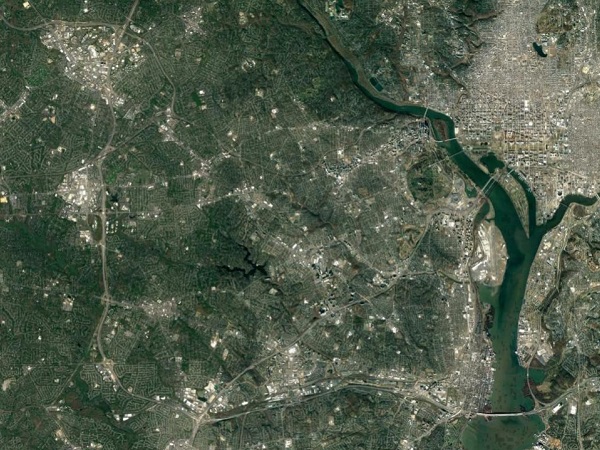Apply now to join our next cohort of Community Science Fellows and Community Leads!

The objectives of this project were to provide a comprehensive analysis of spatial-temporal variability of average and extreme historical precipitation trends and to assess future extreme precipitation changes for multiple planning horizons in the 21st century, i.e., 2040, 2060, 2080, and 2100, by considering the effects of a changing climate. Specifically, the project aims to use climate model projections to enable analysis of precipitation related risks to infrastructure and for identifying the need for additional investments in flood resilient landscapes. A broader understanding of past precipitation patterns is necessary for optimizing future demands on stormwater infrastructure, particularly when combined with a warming climate and regional population growth.
The main project outcomes were as follows:
The northern Virginia region is among the most diverse regions in the United States and serves as a global gateway for the state of Virginia. As part of the National Capital Area, Northern Virginia is growing faster than 37 other states. The Northern Virginia Regional Commission (NVRC) serves as a council of governments for 13 local governments and 2.4 million people across northern Virginia. There is a need in the region for actionable and comprehensive plans to advance climate, energy, and sustainability priorities.
The NVRC and its 13 members, in partnership with the Virginia Coastal Zone Management Program, is working towards the development of a “Resiliency Roadmap” to help the region absorb, recover from, and more successfully adapt to adverse events emanating from extreme weather events and climate-related hazards. Since November 2016, an NVRC-convened team comprised of technical and policy experts from the region’s governmental, commercial, academic and civil society sectors has met five times to assess place-based effects of climate change stressors on the natural and built environment. Among the core environmental stressors confronting the region, heavy precipitation events and the effects on stormwater infrastructure (especially within the context of capital improvement infrastructure planning) was identified as a key priority. Northern Virginia, however, lies between two regions (the northeast and southeast) highlighted the in the National Climate Assessment, each with its own climate projections.
The Project:
NVRC seeks to partner with a local scientist to better understand regional vulnerability scenarios to flooding and runoff based on a comprehensive look at precipitation, population and land use/land change projections for the region. Data for past, current, and future projected rainfall patterns in the northern Virginia region will be integrated with population projections (and development plans, where available) to produce probability statements, scenarios, or GIS layers that can be used by city and county-level planners to help inform future needs for and demands on stormwater infrastructure while considering climate change and regional growth.
Corey Miles, Coastal Resources Program Manager, Northern Virginia Regional Commission
(Photo and biography coming soon!)

Dale Medearis, PhD is a senior environmental planner for the Northern Virginia Regional Commission. In that capacity, he co-leads the NVRC’s regional climate mitigation, energy and resiliency programs and manages NVRC’s international environmental partnerships. He helped co-launch the first formal climate and energy partnership between the 40 largest U.S. and European metropolitan regional councils, co-initiate the Transatlantic Climate Bridge, co-launch the Alexander von Humboldt Foundation’s “Cities and Climate” Network and co-develop the Transatlantic Urban Climate Dialogue with the Freie Universitaet of Berlin (Germany). Prior to working for NVRC, Dale spent approximately 20 years at the Office of International Affairs, U.S. Environmental Protection Agency, Washington, as the program manager for western Europe and urban environmental programs. Dale has a Ph.D. in environmental design and planning from Virginia Tech University, an M.S. in Cartographic and Geographic Science from George Mason University, an M.G.A. in Government from the University of Pennsylvania, and a B.A. in International Relations from the University of Redlands. He is a member of the board of the American Friends of the Alexander von Humboldt Foundation.

Gustavo Coelho is a PhD student in the Department of Civil, Environmental and Infrastructure Engineering at George Mason University, specializing in water resources engineering. His research interests are associated to water resources management, mainly related to flooding mitigation strategies in urban and coastal areas aiming to improve resilience and adaptation. He has more than 8 years of experience in consulting projects related water resources and environmental engineering in Brazil and France.

Ishrat Jahan Dollan is a PhD student in the Department of Civil, Environmental and Infrastructure Engineering at George Mason University, specializing in Water Resources Engineering. Her current research focuses on climate change impact on hydrological processes and developing tools to enhance community resilience to climate change and application of GIS and Remote Sensing to water resources. She has more than 2 years of experience in the field of sustainable management of surface water and groundwater resources at Institute of Water Modelling (IWM) in Bangladesh.

Celso Ferreira is an Assistant Professor in the Civil, Infrastructure and Environmental Engineering Department of George Mason University, specializing in water resources engineering. He is also an Associate Researcher at the USGS National Research Program. His current research interests are associated to water related extreme weather hazards and its impacts to civil engineering infrastructure. He has more than 10 years of experience working in consulting projects related to water resources, environmental and coastal engineering in the US and Brazil.

Paul Houser is a Professor in Geography and Geoinformation Science at George Mason University. He is an internationally recognized expert in local to global land surface-atmospheric remote sensing, in-situ observation and numerical simulation, development and application of hydrologic data assimilation methods, scientific integrity and policy, and global water and energy cycling. His current research focuses on integrating water cycle research across traditional disciplines in an end-to-end program that transitions theoretical research to academic/public education and real-world application, through partnerships with universities, government, and international agencies.

James Kinter is Director of the Center for Ocean-Land-Atmosphere Studies (COLA) at George Mason University where he directs basic and applied climate research conducted by the Center. Jim’s research includes studies of climate predictability on sub-seasonal and longer time scales, focusing on phenomena such as monsoons, El Niño and the Southern Oscillation, and modes of extratropical variability. He is also Professor and Chair in the department of Atmospheric, Oceanic, and Earth Sciences of the College of Science.

Viviana Maggioni is an Assistant Professor of Environmental and Water Resources Engineering. She is also a Visiting Research Associate at the Earth System Science Interdisciplinary Center at the University of Maryland. Her research interests lie at the intersection of hydrometeorology and remote sensing. In particular, she is interested in the application of remote sensing techniques to estimate and monitor hydrological variables. She studies how to improve those retrieval techniques and to enhance estimates of their associated uncertainties. This work has direct applications in water resources management, weather and climate prediction, as well as agriculture and irrigation practices.
AGU_TEE_NVRC_Summary Download
(c) 2024 Thriving Earth Exchange